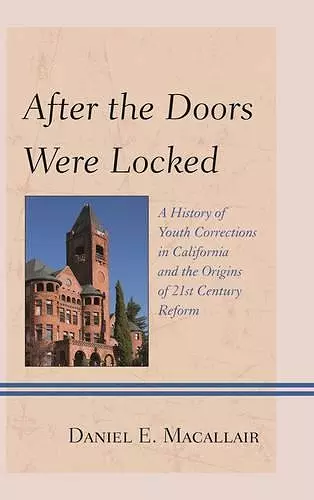After the Doors Were Locked
A History of Youth Corrections in California and the Origins of Twenty-First Century Reform
Daniel E Macallair author Randall G Shelden editor
Format:Hardback
Publisher:Rowman & Littlefield
Published:30th Oct '15
Currently unavailable, and unfortunately no date known when it will be back

The California youth corrections system is undergoing the most sweeping transformation in its 154-year history. The extraordinary nature of this change is revealed by the striking decline in the state’s youth incarceration rate. In 1996, with 10,000 youth confined in 11 state-run correctional facilities, California boasted the nation’s third highest youth incarceration rate. Now, with only 800 youth remaining in a system comprised of just three institutions, California has one of the nation’s lowest youth incarceration rate. How did such unprecedented changes occur and what were the crucial conditions that produced them? Daniel E. Macallair answers these questions through an examination of the California youth corrections system’s origins and evolution, and the patterns and practices that ultimately led to its demise. Beginning in the 19th century, California followed national juvenile justice trends by consigning abused, neglected, and delinquent youth to congregate care institutions known as reform schools. These institutions were characterized by their emphasis on regimentation, rigid structure, and harsh discipline. Behind the walls of these institutions, children and youth, who ranged in age from eight to 21, were subjected to unspeakable cruelties. Despite frequent public outcry, life in California reform schools changed little from the opening of the San Francisco Industrial School in 1859 to the dissolution of the California Youth Authority (CYA) in 2005. By embracing popular national trends at various times, California encapsulates much of the history of youth corrections in the United States. The California story is exceptional since the state often assumed a leadership role in adopting innovative policies intended to improve institutional treatment. The California juvenile justice system stands at the threshold of a new era as it transitions from a 19th century state-centered institutional model to a decentralized structure built around localized services delivered at the county level. After the Doors Were Locked is the first to chronicle the unique history of youth corrections and institutional care in California and analyze the origins of today’s reform efforts. This book offers valuable information and guidance to current and future generations of policy makers, administrators, judges, advocates, students and scholars.
Countless physicians in training encounter the Hippocratic Oath: ‘First, do no harm.’ It is a pity that correctional administrators, their staffs, and the people who set policies and fund juvenile detention institutions do not subscribe to this mantra. The harm they cause is substantial. Macallair, a correctional expert in California, was commissioned by the California State Assembly's Committee on Public Safety to examine juvenile detention from its inception to the present. This brilliant regional history links failures and innovations in the Golden State with key developments occurring elsewhere. What starts politically with enthusiasm eventually ends with changed political priorities and reduced public funding. For example, the establishment of the California Youth Authority in 1942 under Governor Earl Warren brought humane conditions and concerted efforts for rehabilitation. Over time, seeming success resulted in more youths being sentenced, exceeding funding for their care and services. Decline set in. Macallair concludes that congregate youth incarceration generally fails. The high costs—well into six figures annually per juvenile—do not produce low recidivism. Frequently, sadism reigns after the doors are locked. Rehabilitation is opposed, and incapacitation becomes the default policy. Today's credence? Community care seems to work best. Summing Up: Recommended. Upper-division undergraduates and above. * CHOICE *
[I]f you are interested in the incarceration of children and adolescents, but you are not all that familiar with the history of youth corrections, then this book has a lot to offer you. . . .[A]s author Macallair points out in this historically important book, it has taken our society about 190 years to figure out that children should not be locked up because they are poor, lower class, immigrant, or black – or because they are acting like children. -Jim Windell * Michigan Psychological Association *
Macallair's book is a complete and necessary survey of youth corrections that takes careful account of the social, economic, and political factors at play in California's juvenile justice system. -- Ashley Nellis, PhD, Senior Research Analyst, The Sentencing Project
This book provides a comprehensive, detailed account of the development of the juvenile justice system in California. It serves as an excellent resources for the inquiring novelist as well as the experienced researcher. -- Riane M. Bolin, PhD, Assistant Professor , Radford University
Macallair uses a mixture of legislative history, court rulings, factual accounts and public inquiries to lay bare the brutal history of California and the Nation's approach to juvenile delinquency from the gold rush to the present. California has spent millions of dollars on numerous investigations and commissions dating from the late 1800's through the 2015 report by the Center on Juvenile and Criminal Justice. In the words of the philosopher George Santayana "those who cannot learn from history are doomed to repeat it." Everyone involved in any aspect of the juvenile justice system needs to read this book. California is on a precipice: move forward and change, or doom the next generation to the same failures of the Houses of Refuge at the hands of Child Savers. May Macallair's account help Californians make the right choice. -- Andrea F. Joseph, New Mexico State University
ISBN: 9781442246713
Dimensions: 238mm x 160mm x 31mm
Weight: 653g
350 pages